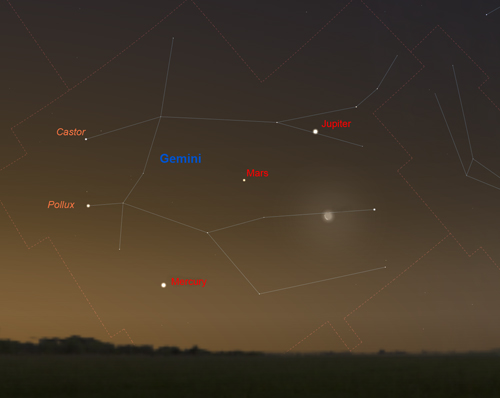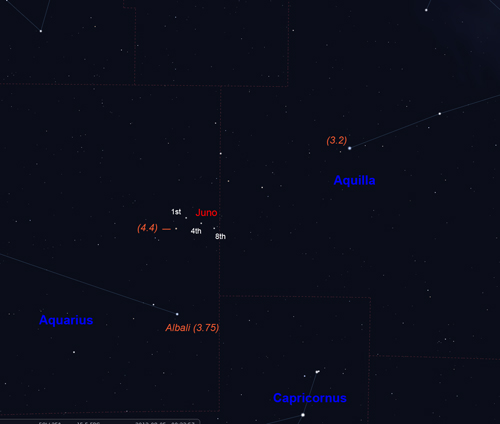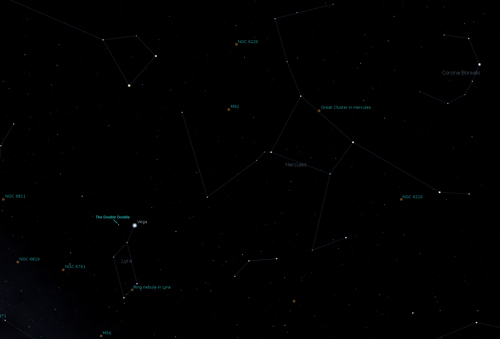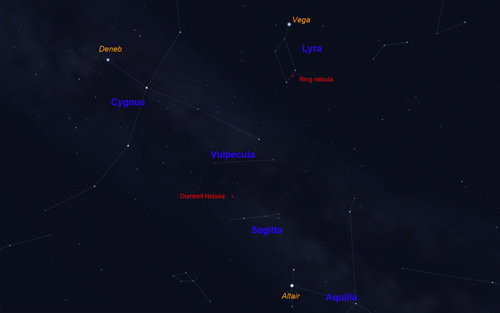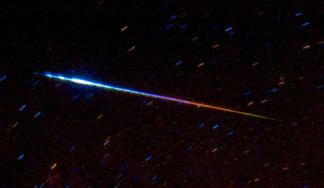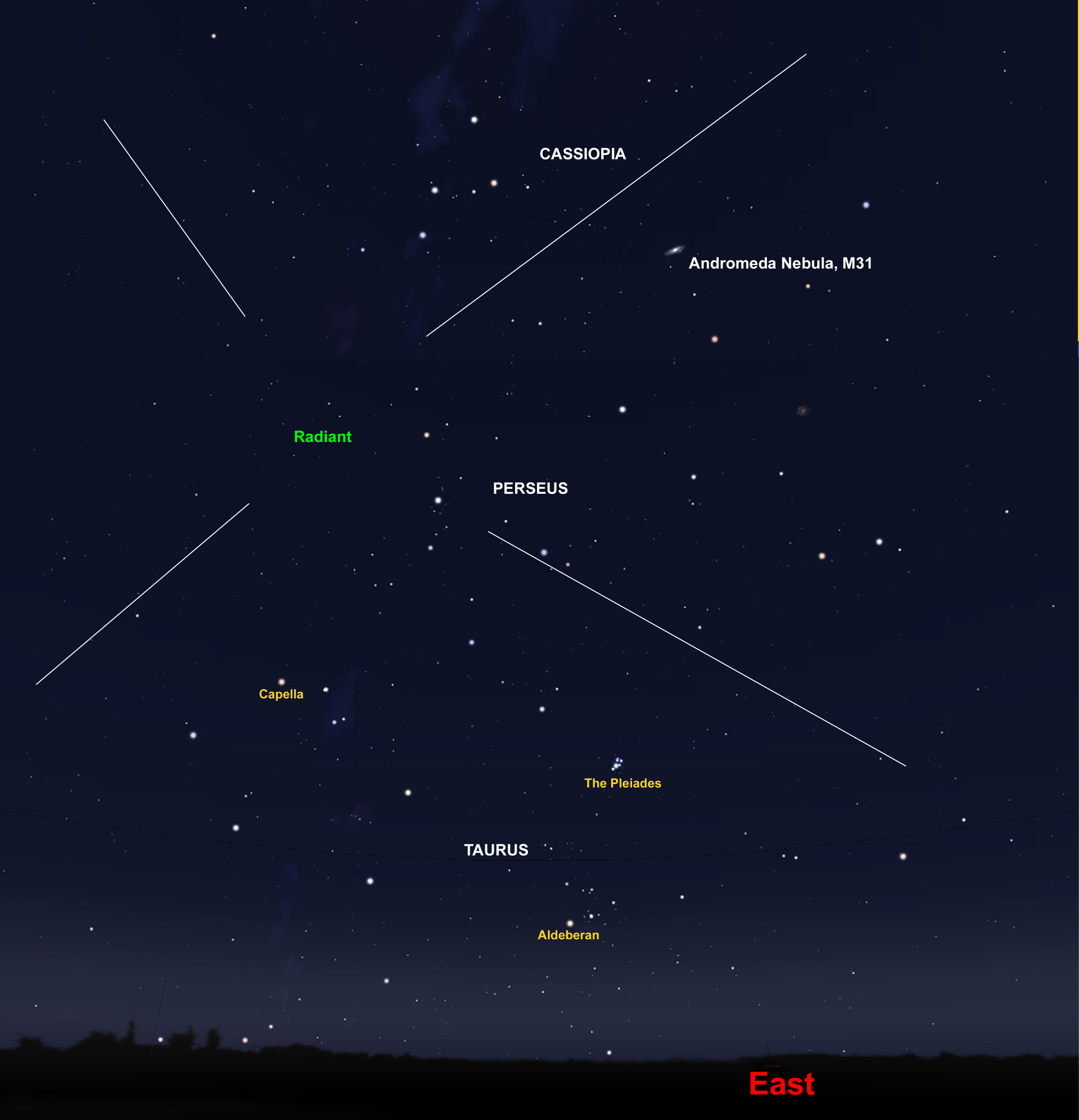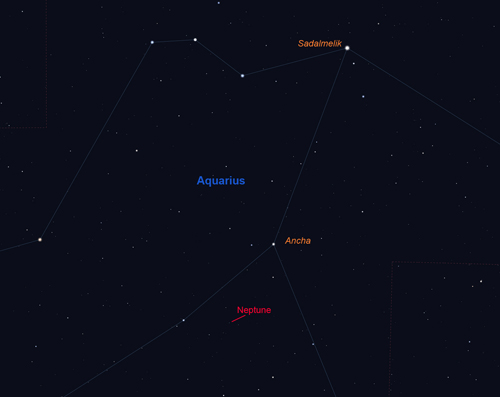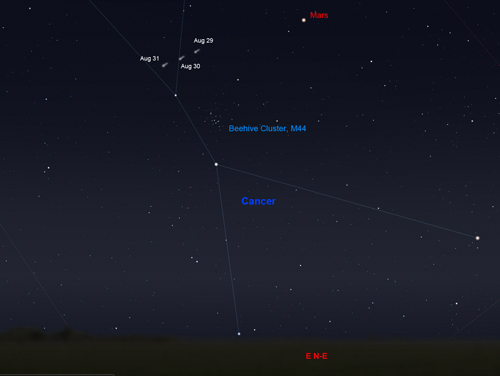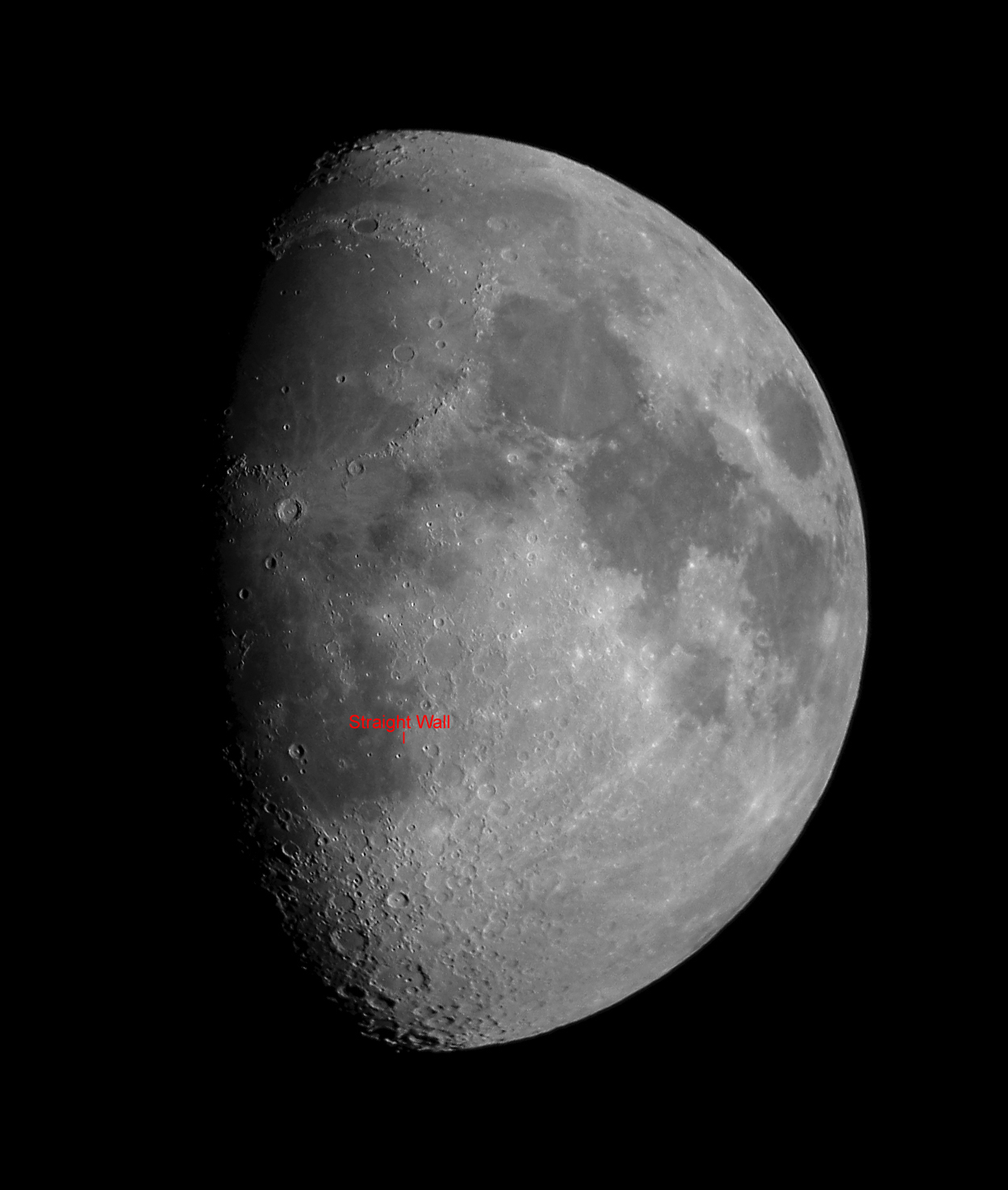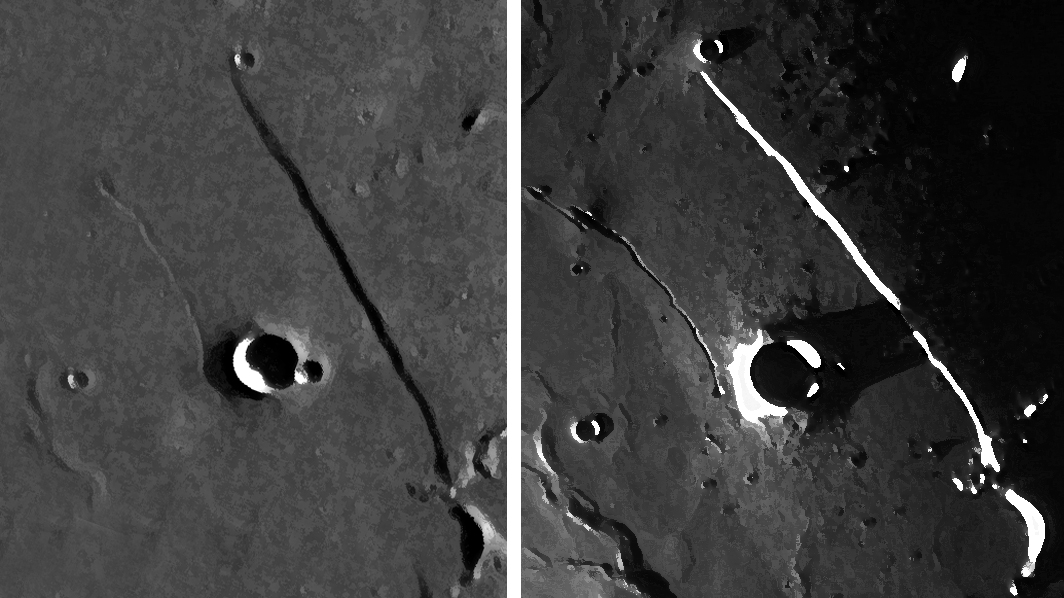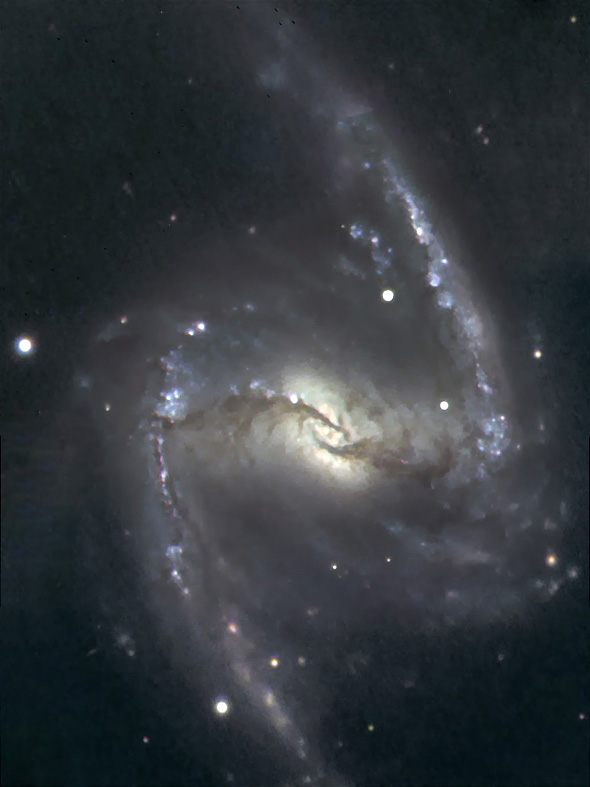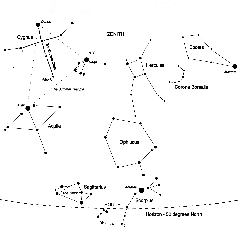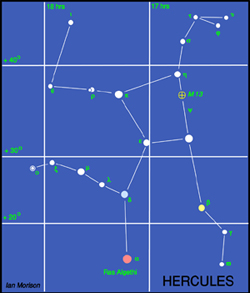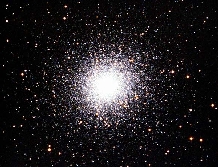The Night Sky August 2013
Compiled by Ian Morison
This page, updated monthly, will let you know some of the things that you can look out for in the night sky. It lists the phases of the Moon, where you will see the naked-eye planets and describes some of the prominent constellations in the night sky during the month.
Image of the Month
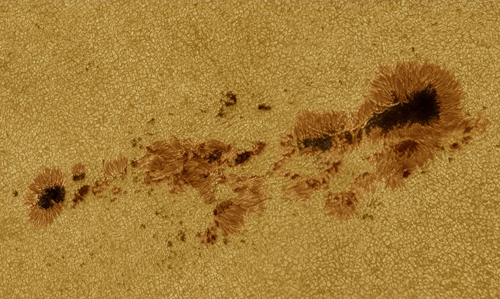
Major Sunspot Group
Image: Damian Peach
This stunning image of one of the largest sunspot regions seen in recent years was taken by the renowned solar system imager, Damian Peach. The sunspots umbra and penumbra are beautifully shown as are the solar granulations - the tops of the convective cells that bring the Sun's heat to the surface.
To see more of Damian Peach's wonderful images of the solar system: Damian Peache's website
Highlights of the Month
August 4th - before dawn : three Planets and a thin crescent Moon
Before dawn on the 4th of August, the planets Jupiter, Mars and Mercury will be joined by a thin crescent Moon making a splendid imaging opportunity.
August 1st - 8th : Try spotting the asteroid Juno
On August 4th, the asteroid Juno is at oppositions and roughly due south at midnight UT. It lies on the border of Aquarius and Aquila as shown in the chart. Juno shines at magnitude 9, so should be visible with 10 x 50 binoculars. Though its irregular shape is only 260 km across, it has a high albedo which explains is high apparent magnitude. Along with Ceres, Pallas and Vesta, it was once classified as a planet but its irregular shape precludes it being classified as a dwarf planet as is Ceres.
August - Find the globular cluster in Hercules and spot the "Double-double" in Lyra
There are two very nice objects to spot with binoculars in the western sky after dark this month. Two thirds of the way up the right hand side of the 4 stars that make up the "keystone" in the constellation Hercules is M13, the best globular cluster visible in the northern sky. Just to the left of the bright star Vega in Lyra is the multiple star system Epsilon Lyrae often called the double-double. With binoculars a binary star is seen but, when observed with a telescope, each of these two stars is revealed to be a double star - hence the name! More details can be found within the "Astronomical A-List" (Link is at upper left.)
August - Use a telescope to view two of the best planetary nebula in the northern sky - The Ring and Dumbbell Nebulae in Lyra and Vulpecular respectivly.
When it gets dark during August the beautiful region of the sky including Cygnus, Lyra and Aquilla will be high in the south south-east. The constellations brightest stars: Vega in Lyra, Deneb in Cygnus and Altair in Aquila making up what is called the summer triangle. Within this region lie two of the brightest planetary nebulae that we can observe in the northern skies. Between Beta and Gamma Lyrae, the pair of bright stars lying below Vega, is the Ring Nebula, M57, seen as a tiny "smoke ring" in a small telescope whilst, below Cygnus in Vulpecula is the Dumbbell Nebula, M27. M27 can even be seen with 10 x 50 binoculars given a dark, transparent, sky. Details of both these beautiful objects can be found within the "Astronomical A List" section of our website (link at upper left) or within the author's book "Pocket Guide to Stars and Galaxies" for which the list was initially produced.
The mornings of August 12th and 13th: midnight to dawn - look out for the Perseid meteor shower.
If clear, these two mornings should give us a great chance of observing the Perseid meteor shower - produced by debris from the comet Swift-Tuttle - as the Moon will not spoil our view. The peak of the shower is actually around mid-day on the 12th so the morning of the 12th should be somewhat better than the 13th, but the peak is quite broad and so there is a second chance to see them on the morning of the 13th. Most meteors are seen looking about 50 degrees from the "radiant" which lies between Perseus and Cassiopeia.
August - A good month to observe Neptune with a small telesocpe.
Neptune comes into opposition - when it is nearest the Earth - on the 27th of August, so will be seen well both this month and next. Its magnitude is +7.9 so Neptune is easily spotted in binoculars lying in the constellation Aquarius as shown on the chart. It rises to an elevation of ~ 27 degrees when due south. Given a telescope of 8 inches or greater aperture and a dark tranparent night it should even be possible to spot its moon Triton. (This is my objective around the end of the month!)
End August before dawn - Comet ISON should becomes visible in a medium sized telescope
Before dawn towards the end of the month and given a 6" or greater telescope, it may be possible to spot comet ISON which will then have a predicted magnitude of +12. On the 31st, it will lie just a couple of degrees above the Beehive Cluster, M44, in Cancer. Comet ISON stand a very good chance of becoming a magnificant comet in a few months time and this page will try to keep you updated as the weeks progress. The app "SkySafari Plus" for ipad and android devices will download the comets orbital elements and show its position in the sky.
August 14th and 27th: The Straight Wall
The Straight Wall
The Straight Wall is best observed either 1 or 2 days after First Quarter (14th August: evening best) or a day or so before Third Quarter (evening of the 27th or 28th August best). To honest, it is not really a wall but a gentle scarp - as Sir Patrick has said "Neither is it a wall nor is it straight!".
A Messier Object imaged with the Faulkes Telescope: M1, The Crab Nebula
Galaxy NGC 1365, imaged by Nik Szymanek.
This image was taken using the Faulkes Telescope by Nik Szymanek - one of the UK's leading astro-photograpers. NGC1365 is also known as the Great Barred Spiral Galaxy and lies at a distance of 56 million light years. It is one of the most perfect barred spirals with a straight bar and two very prominent spiral arms. Closer to the centre there is also a second spiral structure. The galaxy is an excellent "laboratory" for astronomers to study how galaxies form and evolve.
Learn more about the Faulkes Telescopes and how schools can use them: Faulkes Telescope"
Observe the International Space Station

The International Space Station and Jules Verne passing behind the Lovell Telescope on April 1st 2008.
Image by Andrew Greenwood
Use the link below to find when the space station will be visible in the next few days. In general, the space station can be seen either in the hour or so before dawn or the hour or so after sunset - this is because it is dark and yet the Sun is not too far below the horizon so that it can light up the space station. As the orbit only just gets up the the latitude of the UK it will usually be seen to the south, and is only visible for a minute or so at each sighting. Note that as it is in low-earth orbit the sighting details vary quite considerably across the UK. The NASA website linked to below gives details for several cities in the UK. (Across the world too for foreign visitors to this web page.)
Note: I observed the ISS three times recently and was amazed as to how bright it has become.
Find details of sighting possibilities from your location from: Location Index
See where the space station is now: Current Position
The Moon

The Moon at 3rd Quarter. Image, by Ian Morison, taken with a 150mm Maksutov-Newtonian and Canon G7.
Just below the crator Plato seen near the top of the image is the mountain "Mons Piton". It casts a long shadow across the maria from which one can calculate its height - about 6800ft or 2250m.
| new moon | first quarter | full moon | last quarter |
|---|---|---|---|
| August 6th | August 14th | August 21st | August 28th |
Some Lunar Images by Ian Morison, Jodrell Bank Observatory: Lunar Images
A World Record Lunar Image
To mark International Year of Astronomy, a team of British astronomers have made the largest lunar image in history and gained a place in the Guinness Book of Records! The whole image comprises 87.4 megapixels with a Moon diameter of 9550 pixels. This allows details as small as 1km across to be discerned! The superb quality of the image is shown by the detail below of Plato and the Alpine Valley. Craterlets are seen on the floor of Plato and the rille along the centre of the Alpine valley is clearly visible. The image quality is staggering! The team of Damian Peach, Pete lawrence, Dave Tyler, Bruce Kingsley, Nick Smith, Nick Howes, Trevor Little, David Mason, Mark and Lee Irvine with technical support from Ninian Boyle captured the video sequences from which 288 individual mozaic panes were produced. These were then stitched together to form the lunar image.
Please follow the link to the Lunar World Record website and it would be really great if you could donate to Sir Patrick Moore's chosen charity to either download a full resolution image or purchase a print.
The Planets
All the planets are visible this month, but none are well placed in the sky for northern hemisphere observers - except perhaps Neptune which reaches opposition on August 28th as described in one of the month's highlights.
Jupiter
Jupiter rises about 03:30 BST at the beginning of August so is visible in the pre-dawn sky shining at magnitude -1.9 with a disk ~33 arc seconds across. But, as the ecliptic is at quite a shallow angle to the horizon it will still be only ~20 degrees above the horizon some 45 minutes before sunrise. Binoculars may well be needed to spot it but please cease using them when the Sun rises. Following its conjunction with Mars on July 22nd, it will still lie within 5 degrees of Mars at the beginning of the month By month's end Jupiter rises some three to four hours before the Sun lying between the feet of the heavenly twins, Gemini, and so will be far easier to spot. A small telescope should then be able to image the four gallilean moons as they weave their way around it.
See highlight above
Saturn
Saturn, lying in Virgo, is now several months past opposition so will be seen in the south west after sunset. It lies 11 degrees to the left of Spica, Alpha Virginis and will appear slightly brighter with a yellowish hue. Saturn's magnitude remains at +0.7 during the month, whilst its angular size decreases a little from 16.7 to 16.2 arc seconds. It begins the month just just 1 degree away from the the magnitude +4.2 star, Kappa Virginis. Saturn, having ended its retrogarde motion across the sky is now moving eastwards between the the stars Spica and Alpha Librae. The rings have now opened out to ~17 degrees from the line of sight and we are now observing the planet's southern hemisphere whilst much of the northern hemisphere will be hidden by the rings. Though now seen at relativly low elevation, with a small scope it should still be possible to spot Saturn's largest moon, Titan, and just possibly Cassini's Division within the rings if the "seeing" is good. Saturn is now lying in the more southerly part of the ecliptic so its elevation does not get that high when seen from our northern latitudes. Sadly, this will get worse for quite a number of years to come.
Mars
Mars starts August in in Gemini but, moving quickly across the sky, moves into Cancer on August 25th. It will lie about 15 degrees above the north-eastern horizon 45 minutes before sunrise as August begins and should be visible in binoculars in the pre-dawn sky - but please cease using them at sunrise! Its magnitude of +1.6 remains constant during the month. Its angular size of 4 arc seconds will not allow any markings to be seen on its salmon-pink surface.
See highlight above
Mercury
Mercury. At then end of July, Mercury was at greatest western elongation, so will still be seen in the pre-dawn sky at the start of August. It brightens during the month from -0.5 to -0.8 magnitudes but, at the same time drops back towards the horizon making it harder to spot. It will be lost to view from the middle of the month as it moves towards superior conjunction (on the far side of the Sun) on August 24th. Interestingly, Mercury passes 4 degrees below comet ISON on the 8th, expected to be about magnitude 13 so not easy to observe but, when they next become close on November 23rd with a seperation of just 4.7 degrees, they could have a comparable brightness!
See highlight above
Venus
Venus. As August begins, Venus is 32 degrees east of the Sun at Sunset, but as the plane of the ecliptic is at a shallow angle to the horizon at this time of the year, it will only be 11 degrees above the horizon when observed in the pre-dawn sky. Its angular seperation from the Sun increase steadily to 39 degrees during the month, but, as the angle between the horizon and the ecliptic reduces, its elevation after sunset does not really increase. Venus brightens slightly to magnitude -4 from -3.9 during the month whilst it angular size increases from 12.8 to 14.2. Venus is moving rapidly across the sky from Leo into Virgo and ends August just 5 degrees from Spica, Alpha Virginis.
Find more planetary images and details about the Solar System: The Solar System
The Stars
The mid evening August Sky
Now that the evenings are drawing in, the night sky gets darker earlier so encouraging one to go out to observe.
This map shows the constellations seen towards the south at about 10pm BST in mid August. High over head towards the north (not shown on the chart) lies Ursa Major. As one moves southwards one first crosses the constellation Hercules with its magnificent globular cluster, M13, and then across the large but not prominent constellation Ophiucus until, low above the souther horizon lie Sagittarius and Scorpio. To the right of Hercules lie the arc of stars making up Corona Borealis and then Bootes with its bright star Arcturus. Rising in the east is the beautiful region of the Milky Way containing both Cygnus and Lyra. Below is the constellation of Aquilla, the Eagle. The three bright stars Deneb (in Cygnus), Vega (in Lyra) and Altair (in Aquila) make up the "Summer Triangle".
The constellation Ursa Major
The stars of the Plough, shown linked by the thicker lines in the chart above, form one of the most recognised star patterns in the sky. Also called the Big Dipper, after the soup ladles used by farmer's wives in America to serve soup to the farm workers at lunchtime, it forms part of the Great Bear constellation - not quite so easy to make out! The stars Merak and Dubhe form the pointers which will lead you to the Pole Star, and hence find North. The stars Alcor and Mizar form a naked eye double which repays observation in a small telescope as Mizar is then shown to be an easily resolved double star. A fainter reddish star forms a triangle with Alcor and Mizar.
Ursa Major contains many interesting "deep sky" objects. The brightest, listed in Messier's Catalogue, are shown on the chart, but there are many fainter galaxies in the region too. In the upper right of the constellation are a pair of interacting galaxies M81 and M82 shown in the image below. M82 is undergoing a major burst of star formation and hence called a "starburst galaxy". They can be seen together using a low power eyepiece on a small telescope.
Another, and very beautiful, galaxy is M101 which looks rather like a pinwheel firework, hence its other name the Pinwheel Galaxy. It was discovered in1781 and was a late entry to Messier's calalogue of nebulous objects. It is a type Sc spiral galaxy seen face on which is at a distance of about 24 million light years. Type Sc galaxies have a relativly small nucleus and open spiral arms. With an overall diameter of 170,000 light it is one of the largest spirals known (the Milky Way has a diameter of ~ 130,000 light years).
Though just outside the constellation boundary, M51 lies close to Alkaid, the leftmost star of the Plough. Also called the Whirlpool Galaxy it is being deformed by the passage of the smaller galaxy on the left. This is now gravitationally captured by M51 and the two will eventually merge. M51 lies at a distance of about 37 million light years and was the first galaxy in which spiral arms were seen. It was discovered by Charles Messier in 1773 and the spiral structure was observed by Lord Rosse in 1845 using the 72" reflector at Birr Castle in Ireland - for many years the largest telescope in the world.
Lying close to Merak is the planetary nebula M97 which is usually called the Owl Nebula due to its resemblance to an owl's face with two large eyes. It was first called this by Lord Rosse who drew it in 1848 - as shown in the image below right. Planetary nebulae ar the remnants of stars similar in size to our Sun. When all possible nuclear fusion processes are complete, the central core collpses down into a "white dwarf" star and the the outer parts of the star are blown off to form the surrounding nebula.
The constellation Hercules
Between the constellation Bootes and the bright star Vega in Lyra lies the constellation Hercules.The Red Giant star Alpha Herculis or Ras Algethi, its arabic name, is one of the largest stars known, with a diameter of around 500 times that of our Sun. In common with most giant stars it varies its size, changing in brightness as it does so from 3rd to 4th magnitude. Lying along one side of the "keystone" lies one of the wonders of the skies, the great globular cluster, M13. Just visible to the unaided eye on a dark clear night, it is easily seen through binoculars as a small ball of cotten wool about 1/3 the diameter of the full Moon. The brightness increases towards the centre where the concentration of stars is greatest. It is a most beautiful sight in a small telescope. It contains around 300,000 stars in a region of space 100 light years across, and is the brightest globular cluster that can be seen in the northern hemisphere.
The constellation Virgo
Virgo, in the south-east after sunset this month, is not one of the most prominent constellations, containing only one bright star, Spica, but is one of the largest and is very rewarding for those with "rich field" telescopes capable of seeing the many galaxies that lie within its boundaries. Spica is, in fact, an exceedingly close double star with the two B type stars orbiting each other every 4 days. Their total luminosity is 2000 times that of our Sun. In the upper right hand quadrant of Virgo lies the centre of the Virgo Cluster of galaxies. There are 13 galaxies in the Messier catalogue in this region, all of which can be seen with a small telescope. The brightest is the giant elliptical galaxy, M87, with a jet extending from its centre where there is almost certainly a massive black hole into which dust and gas are falling. This releases great amounts of energy which powers particles to reach speeds close to the speed of light forming the jet we see. M87 is also called VIRGO A as it is a very strong radio source.
Below Porrima and to the right of Spica lies M104, an 8th magnitude spiral galaxy about 30 million light years away from us. Its spiral arms are edge on to us so in a small telescope it appears as an elliptical galaxy. It is also known as the Sombrero Galaxy as it looks like a wide brimmed hat in long exposure photographs.
The constellations Lyra and Cygnus
This month the constellations Lyra and Cygnus are rising in the East as darkness falls with their bright stars Vega, in Lyra, and Deneb, in Cygnus, making up the "summer triangle" of bright stars with Altair in the constellation Aquila below. (see sky chart above)
Lyra
Lyra is dominated by its brightest star Vega, the fifth brightest star in the sky. It is a blue-white star having a magnitude of 0.03, and lies 26 light years away. It weighs three times more than the Sun and is about 50 times brighter. It is thus burning up its nuclear fuel at a greater rate than the Sun and so will shine for a correspondingly shorter time. Vega is much younger than the Sun, perhaps only a few hundred million years old, and is surrounded by a cold,dark disc of dust in which an embryonic solar system is being formed!
There is a lovely double star called Epsilon Lyrae up and to the left of Vega. A pair of binoculars will show them up easily - you might even see them both with your unaided eye. In fact a telescope, provided the atmosphere is calm, shows that each of the two stars that you can see is a double star as well so it is called the double double!
Between Beta and Gamma Lyra lies a beautiful object called the Ring Nebula. It is the 57th object in the Messier Catalogue and so is also called M57. Such objects are called planetary nebulae as in a telescope they show a disc, rather like a planet. But in fact they are the remnants of stars, similar to our Sun, that have come to the end of their life and have blown off a shell of dust and gas around them. The Ring Nebula looks like a greenish smoke ring in a small telescope, but is not as impressive as it is shown in photographs in which you can also see the faint central "white dwarf" star which is the core of the original star which has collapsed down to about the size of the Earth. Still very hot this shines with a blue-white colour, but is cooling down and will eventually become dark and invisible - a "black dwarf"! Do click on the image below to see the large version - its wonderful!
M56 is an 8th magnitude Globular Cluster visible in binoculars roughly half way between Alberio (the head of the Swan) and Gamma Lyrae. It is 33,000 light years away and has a diameter of about 60 light years. It was first seen by Charles Messier in 1779 and became the 56th entry into his catalogue.
Cygnus
Cygnus, the Swan, is sometimes called the "Northern Cross" as it has a distinctive cross shape, but we normally think of it as a flying Swan. Deneb,the arabic word for "tail", is a 1.3 magnitude star which marks the tail of the swan. It is nearly 2000 light years away and appears so bright only because it gives out around 80,000 times as much light as our Sun. In fact if Deneb where as close as the brightest star in the northern sky, Sirius, it would appear as brilliant as the half moon and the sky would never be really dark when it was above the horizon!
The star, Albireo, which marks the head of the Swan is much fainter, but a beautiful sight in a small telescope. This shows that Albireo is made of two stars, amber and blue-green, which provide a wonderful colour contrast. With magnitudes 3.1 and 5.1 they are regarded as the most beautiful double star that can be seen in the sky.
Cygnus lies along the line of the Milky Way, the disk of our own Galaxy, and provides a wealth of stars and clusters to observe. Just to the left of the line joining Deneb and Sadr, the star at the centre of the outstretched wings, you may, under very clear dark skys, see a region which is darker than the surroundings. This is called the Cygnus Rift and is caused by the obscuration of light from distant stars by a lane of dust in our local spiral arm. the dust comes from elements such as carbon which have been built up in stars and ejected into space in explosions that give rise to objects such as the planetary nebula M57 described above.
Deneb,the arabic word for "tail", is a 1.3 magnitude star which marks the tail of the swan. It is nearly 2000 light years away and appears so bright only because it gives out around 80,000 times as much light as our Sun. In fact if Deneb where as close as the brightest star in the northern sky, Sirius, it would appear as brilliant as the half moon and the sky would never be really dark when it was above the horizon!
There is a beautiful region of nebulosity up and to the left of Deneb which is visible with binoculars in a very dark and clear sky. Photographs show an outline that looks like North America - hence its name the North America Nebula. Just to its right is a less bright region that looks like a Pelican, with a long beak and dark eye, so not surprisingly this is called the Pelican Nebula. The photograph below shows them well.
Brocchi's Cluster An easy object to spot with binoculars in Gygnus is "Brocchi's Cluster", often called "The Coathanger",although it appears upside down in the sky! Follow down the neck of the swan to the star Alberio, then sweep down and to its lower left. You should easily spot it against the dark dust lane behind.


